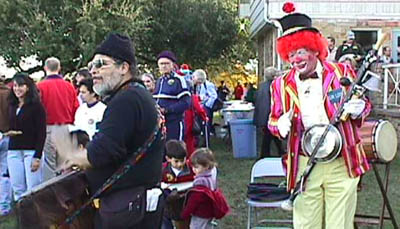| 









|

Drum Circle FAQ |
Drum Circle @ Rhythmweb
Home

Getting Started in Drumming
OK, I'm excited. How
do I get started?
Square One: Rhythm is a state of mind. Your
every moment is steeped in rhythmic processes. Your breathing, your
pulse and heartbeat, your steps, the way you brush your teeth, all have
a natural rhythm. Pay attention. Be aware of natural rhythms as they
occur; this is the first step. Awareness of rhythms can be practiced
anywhere, any time. A drum is nopt required. The bird singing outside
your window can teach you quite a bit, if you're willing to give him
your attention for a few moments. Rhythm isn't a temporary activity;
it's a way of life. Turn on the radio in your car and do a bit of channel
surfing. Find types of music you don't normally listen to, and pay careful
attention to the rhythms. Pick out the various parts, and see if you
can repeat them to yourself.
Verbalizing rhythms is a valid way of practicing. As
the old saying goes, "If you can say it, you can play it."
Some cultures (India comes to mind) even require that the student learn
to "speak" the rhythms before touching a drum. Many teachers
of Jembe and Ashiko are adopting the system popularized by Baba Olatunji.
He uses syllables which resemble the Bass, tone, and slap sounds of
african jembes and ashikos. Gun, dun (Goon, Doon) for bass, go, do for
tones, and pa, ta for slaps.
Whether you speak the rhythms vocally or find yourself
tapping them out on the dashboard of the car or the pasta pot in the
kitchen, rest assured: your journey has already begun. Rhythm is a state
of mind.
2. Get a drum or assemble playing materials.
Your choices here will depend much on your budget, your
initial level of enthusiasm, and who if anyone you've chosen as a teacher.
You do not have to buy a drum right away.
Visit our HOMEMADE
PERCUSSION section for inexpensive ideas. Sometimes it makes more
sense to wait and do a little more research into the various possibilities.
Don't worry if you don't have a teacher at first. When the time comes,
your teacher will be there. Play at least a little every day. Time is
your canvas, and sound is your paint. Use the time to connect with the
joy of playing. Community drum circles are a good place to pick up tips
and tricks, and meet potential teachers and playing buddies. Videos
can give you a great deal to work on too, so that when you find a good
teacher, you'll already have some of the basics down. That saves time;
now the teacher can show you more advanced things.
3. Get instruction and practice daily
Eventually you will choose a drum, and begin to learn
some rhythms. Whichever instrument or instruments you choose, keep in
mind that you are encountering a tradition which has taken many centuries
to develop. The tips and tricks of the masters are available to you
if you respectfully seek them out. Don't try to re-invent the wheel.
Learn about the culture from which your instrument comes, and learn
to play the standard rhythms for that instrument. This will pave the
way for much progress as time goes by. The learning is the fun part.
When you have put in an hour or two of practice, and you are warmed
up, things come to your hands that you would otherwise not have come
up with. The practice becomes its own reward, and your time spent playing
may even increase, for love of doing it..
Coming soon:
- a teacher: the company of the wise...
- videos: the next best thing...
- daily practice:
a must for real progress ...
4. Seek out like minded individuals.
- the small circle of friends
- The bigger community circles
- The drumming community as a whole
5. Reaching out. Working with kids, and older
people.
"Eventually you will choose a drum, and begin to learn some rhythms. There are good online resources for this, like Takelessons.com ” |